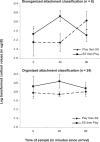Examining infants' cortisol responses to laboratory tasks among children varying in attachment disorganization: stress reactivity or return to baseline?
- PMID: 20873923
- PMCID: PMC3209263
- DOI: 10.1037/a0020660
Examining infants' cortisol responses to laboratory tasks among children varying in attachment disorganization: stress reactivity or return to baseline?
Abstract
Cortisol is a hormone involved in mounting a stress response in humans. The evidence of stress reactivity among young children has been mixed, however. In the present study, the order of two laboratory tasks (i.e., Strange Situation and play) was counterbalanced, and home saliva samples were obtained. Saliva samples were also collected upon the children's arrival at the laboratory and at 40, 65, and 80 min after arrival. The authors examined changes in cortisol using piecewise hierarchical linear modeling, testing whether observed increases reflected a return to baseline or stress reactivity. An interaction between attachment disorganization and task emerged, such that disorganized infants showed increases in cortisol in response to the stressor compared with play, whereas organized infants did not show cortisol reactivity to either task. Implications for the buffering effects of maternal care on stress reactivity are discussed.
Figures
References
-
- Ainsworth MDS, Blehar MC, Waters E, Walls S. Patterns of attachment: A psychological study of the Strange Situation. Erlbaum; Hillsdale, NJ: 1978.
-
- Carlson EA. A prospective longitudinal study of attachment disorganization/disorientation. Child Development. 1998;69:1107–1128. - PubMed
-
- Dettling AC, Gunnar MR, Donzella B. Cortisol levels of young children in full-day child care centers: Relations with age and temperament. Psychoneuroendocrinology. 1999;24:519–536. - PubMed
-
- Dettling AC, Parker S, Lane SK, Sebanc AM, Gunnar MR. Quality of care and temperament determine whether cortisol levels rise over the day for young children in childcare. Psychoneuroendocrinology. 2000;25:819–836. - PubMed
-
- Dickerson SS, Kemeny ME. Acute stressors and cortisol responses: A theoretical integration and synthesis of laboratory research. Psychological Bulletin. 2004;130:355–391. - PubMed



